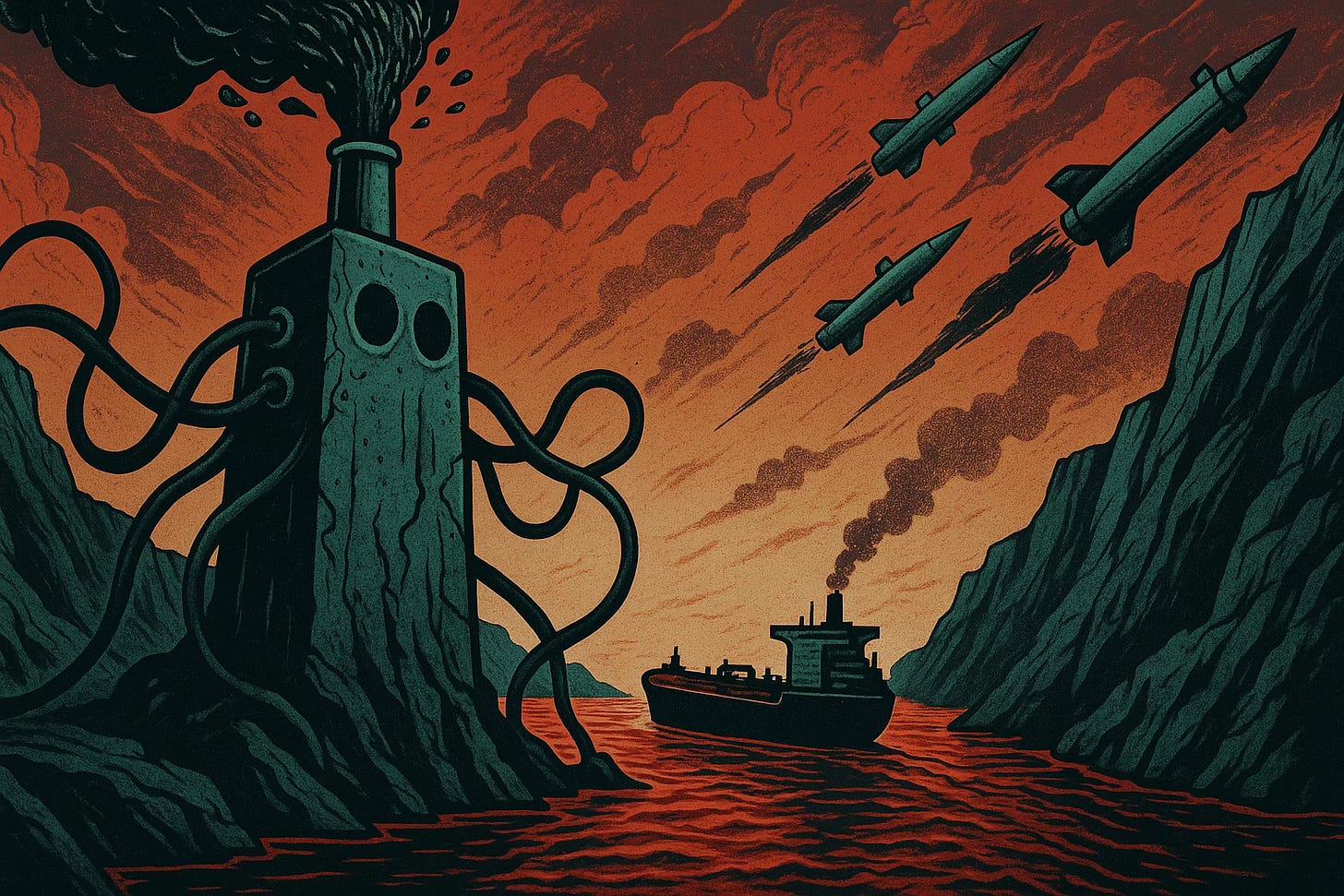Hormuz Is Not Fragile. The Narrative Is.
Separating geopolitical myth from operational reality
The Strait of Hormuz has long been presented as a financial kill switch. A fragile artery, barely 21 miles wide, through which a fifth of the world’s oil flows. One missile, one mine, one political miscalculation away from $200 oil and instant global recession. At least, that’s the story.
The media loves it. Markets flinch every time Tehran utters the phrase “closure.” Talking heads warn of global collapse. Analysts publish breathless forecasts. But behind the drama lies a simpler truth: the Strait is vulnerable, yes—but the world isn’t nearly as fragile as it once was.
Roughly 20 million barrels of oil pass through the Strait daily, mostly bound for Asia. China, India, Japan—energy-hungry giants that rely on this narrow channel for a lifeline. Iran knows this. So do its adversaries.
Tehran’s threats aren’t new. Whenever tensions spike—sanctions, assassinations, strikes—the Strait reappears in the headlines. It’s Iran’s geopolitical scarecrow. Don’t touch us, or the world burns.
In theory, it sounds effective. If Iran’s oil can’t flow, nobody’s can. A self-destruct button disguised as strategy. But in practice, the story doesn’t quite hold up.
Yes, Iran has fast boats, missiles, drones. They can harass shipping, maybe even sink a tanker. But sustaining a full blockade is a different animal. The U.S. Navy isn’t just a presence in the region—it’s the most sophisticated fighting force on the planet. Operation Praying Mantis in 1988 proved how quickly Iran’s naval assets can be dismantled. That lesson hasn’t aged.
Even now, American carrier strike groups patrol the area. The Strait isn’t undefended. It’s under constant watch, surrounded by sonar, satellites, and surveillance drones. One misstep from Iran, and retaliation comes fast and hard.
But the real reason Iran can’t close the Strait? Economics.
Nearly 90% of its own oil exports pass through the same corridor. Cut it off, and Iran strangles itself before it hurts anyone else. And that assumes China, its largest customer, would tolerate the disruption. Spoiler: it wouldn’t.
Beijing’s energy security depends on that oil. And while China and Iran maintain warm diplomatic ties, those bonds are transactional. Disrupting Chinese supply chains is not in Tehran’s long-term interest. When your only lifeline leads through a bottleneck, blowing up the bottle isn’t strategy—it’s suicide.
The doomsday forecasts also ignore how much the world has changed.
The United States is no longer chained to foreign oil. Shale transformed the game. The U.S. is now a net energy exporter, and when prices rise, shale rigs spin back to life. American supply can ramp faster than most think. Not instantly, but quickly enough to matter.
Strategic petroleum reserves exist for exactly this reason. The IEA coordinates drawdowns among major consuming nations. It’s not a perfect system, but it’s there—and it works.
There are also alternatives. Saudi Arabia’s East-West pipeline can move millions of barrels a day directly to the Red Sea, bypassing the Strait. The UAE has similar infrastructure. These routes are slower and more expensive, but in a crunch, they function.
Insurance markets, oddly enough, tell the real story. Lloyd’s and other maritime insurers still write coverage for Gulf shipping. Premiums rise during crises, but not catastrophically. If the underwriters of last resort aren’t panicking, maybe the rest of us shouldn’t either.
Military technology adds another layer. Iran’s drones and missiles are real threats—but they’re not unstoppable. Modern warships are bristling with electronic warfare suites, missile interceptors, and countermeasures. The idea that a few fast boats could hold the global economy hostage feels less plausible with every passing year.
And then there’s the market. Oil futures wobble whenever Hormuz headlines flare, but they rarely explode. No sustained pricing in of disaster. Traders may be paranoid, but they aren’t stupid. The wisdom of the crowd seems clear: disruption, maybe. Apocalypse, no.
The energy transition plays a supporting role. Renewables are still small, but growing. EV adoption, slow but steady, is reshaping long-term demand curves. The global economy isn’t post-oil, but it’s less oil-addicted than it used to be. That matters.
Iran’s leaders also have domestic realities to contend with. The public, already weary from years of sanctions, inflation, and isolation, might not take kindly to an act that invites even more pain. Shutting down the Strait would trigger military retaliation and economic collapse. That’s a hard sell—even in Tehran.
And strategically, the threat itself is more useful than the act. As long as the Strait could be closed, Iran retains leverage. Once it is closed, they lose that ambiguity. Bluff spent, consequences real.
The rest of the region isn’t passive either. Saudi Arabia, the UAE, and Kuwait have no interest in watching their own oil exports disappear. They’d support a global response to any closure—quietly or loudly. It wouldn’t be just Washington reacting.
Yes, prices would rise. Gas would get more expensive. Airlines would feel it. So would shipping, trucking, heating. Emerging markets dependent on imported oil would suffer most. But suffering isn’t collapse. And pain isn’t the same thing as chaos.
The COVID-19 pandemic showed just how much damage the world can take and still keep moving. Oil shock scenarios don’t quite hit the same anymore.
Iran could try to close the Strait. But keeping it closed? That’s a war they’d almost certainly lose.
The Strait of Hormuz is a geopolitical flashpoint—but it’s not the Achilles’ heel of the global economy. The hype serves political and media agendas more than serious analysis. It’s theater wrapped in a warning.
And next time you hear about the Strait’s closure, remember: the gap between Iran’s threat and its actual capacity is wider than the Strait itself.



